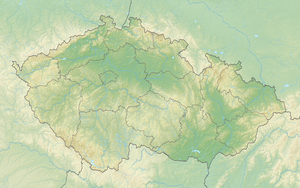Sovinec Castle
| Sovinec Castle | ||
|---|---|---|
| Alternative name (s): | Eulenburg | |
| Creation time : | 14th Century | |
| Geographical location | 49 ° 50 '15 " N , 17 ° 14' 44.9" E | |
|
|
||
The castle Sovinec (German Eulenburg ) is located north of Sovinec ( Eulenberg ) in the Okres Bruntál in the Czech Republic . It lies on a wide rock spur in the foothills of the Lower Jeseníky , 13 kilometers south of Rýmařov .
history
The Eulenburg was built around 1320 by the brothers Wok and Paul and was first mentioned in 1333. The builders came from the Moravian noble family of the Hrut and previously settled at the Waldhausen fortress near Huzová . Only after they moved their headquarters to the newly built Eulenburg ( Hrad Sovinec ) near Eulenberg ( Sovinec ) did they call themselves de "Aulnburk" and later from Sovinec . The castle was referred to as “Sovinecz” in the Czech spelling for the first time in 1353 in the corresponding entry in the Olomouc country table .
During the Hussite Wars , the castle was one of the important fortresses of the Hussites . In 1492 Wok Pniowsky von Eulenberg acquired the Eulenburg with the rule of Eulenberg. In 1543 both were acquired by Christoph von Boskowitz , who introduced the Reformation and had the castle rebuilt in the Renaissance style . Jáchym Pivce z Hradčan a Klimštejna was captain of the castle from 1577 to 1583 . 1578–1592, the castle was owned by the mining entrepreneur Lorenz Eder von Sstiawnicz ( Vavřinec Eder z Štiavnic ), the pledgee of the neighboring Rabenstein manor . He was followed by his son-in-law Jan d. Ä. Kobylka von Kobylí, who had to sell his goods to Karl von Liechtenstein because of his participation in the uprising after the battle of the White Mountain . He handed the castle over to the Teutonic Order in 1623 .
After the Danish-Saxon occupation in 1626/27, the castle was expanded into a fortress by the governor Georg Wilhelm von Elkershausen. Three more cannon bastions were built, the defensive walls reinforced, the moat deepened and another tower in front of it was built. After a siege lasting several weeks, the Swedes occupied the strategically important castle in October 1643 under the leadership of General Lennart Torstensson and held it until 1650. After a fire in 1784, the Teutonic Order only carried out the most necessary repairs and in 1812 auctioned parts of the now ruined castle. These parts were bought back in 1837 under Grand Master Archduke Max Joseph .
From 1840 the castle served as a boys' convent for the Teutonic Order, to which the memorial plaque for Peter Rigler refers. After it was moved to Troppau between 1867 and 1896 as the seat of the Silesian-Moravian Higher Education Institute for Forests. During the reign of the National Socialists , the Teutonic Order was expropriated in 1939 and set up in the castle in a prison camp for French officers until 1943. During the last days of the war in 1945, the castle burned down completely and fell into disrepair. Its restoration began in 1951.
literature
- Joachim Bahlcke , Winfried Eberhard, Miloslav Polívka (eds.): Handbook of historical places . Volume: Bohemia and Moravia (= Kröner's pocket edition . Volume 329). Kröner, Stuttgart 1998, ISBN 3-520-32901-8 , pp. 138-139.
Web links
Individual evidence
- ↑ Burghauptmann ( Memento of the original from September 28, 2007 in the Internet Archive ) Info: The archive link was inserted automatically and has not yet been checked. Please check the original and archive link according to the instructions and then remove this notice. on hradsovinec.cz (Czech).

